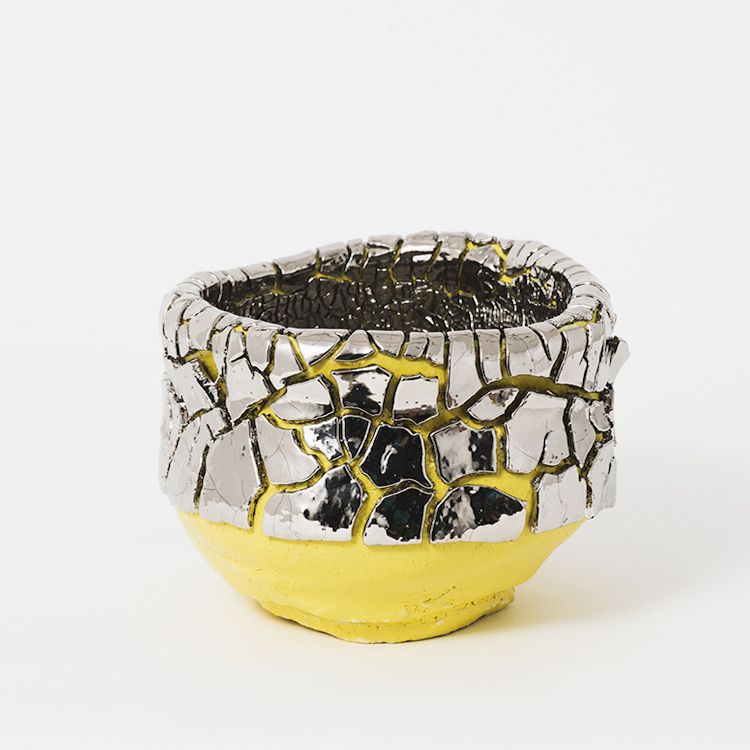LONDON — The excitement around From Tea Bowl, an exhibition by Japanese artist Takuro Kuwata at Alison Jacques Gallery, began on install day; several cranes had to be hired to hoist the work through the glass fronted gallery in the middle of Central London, a spectacle that was sustained throughout the run of the show. On the rainy day that I visited, the shining, colourful, enormous objects seemed all the more intriguing from that dark street corner, and there were several passers by who obviously thought so too, their faces pressed against the window.
Above Image: Takuro Kuwata, Tea Bowl, 2016, photo courtesy of Alison Jacques Gallery, London
“I’m not trying to break the rules… I just want to apply a contemporary sensibility to pottery. I believe I can create something truly new, work that reflects our time.” — Takuro Kuwata, 2013

Takuro Kuwata, From Tea Bowl (Installation View), 2016, photo by Andy Keate, courtesy of Alison Jacques Gallery, London
From Tea Bowl (October 7 – November 5) was Kuwata’s first U.K. solo show. A response to a previous exhibition, Dear Tea Bowl at Salon 94 (Freemans, New York, September 9, 2015 – October 25, 2015), this was an ambitious undertaking in experimentation, not least in the sheer scale of what has been produced.
Whilst Kuwata lives and works in Toki City, Gifu, Japan, a mountainous terrain that influences his work in a very direct way, the work for this show was largely made on residency in Shigaraki, Japan earlier this year. The mammoth scale of the sculptures confront the audience immediately on entering the gallery, the way almost blocked by an imposing stalagmite of lime green, fleshy pink gum barely gripping to its surface, like some radioactive relic from an anime film.

Takuro Kuwata, Untitled, 2016, porcelain, glaze, pigment, steel, 185 x 50 x 50 cm, photo courtesy of Alison Jacques Gallery, London. Photo: Robert Glowacki
Born in Hiroshima, it appears his personal and national history is echoed in these gaudy and excessive objects, perhaps a comment on the uncertainty of the natural and political world we live in. Whilst Kuwata references Japan’s recent natural and social disasters, the sculptures’ peeling skin and erupting surfaces could easily be seen to suggest the surreal technicolour of the current political climate of the West as well; dripping with distracting, shiny surfaces that barely hide the instability beneath.
One gets the sense that the work, for all its cartoon colouring, is grounded in the environment of its construction. He uses local clays, rocks from the mountains near his home, leaves vats of glaze out in the midday heat to grow mould. It perhaps seems incongruous to suggest that these very contemporary looking sculptures are so tied to historical traditions, but despite his quest to create “something truly new,” it seems to me that Kuwata is a bit of a traditionalist.
The work doesn’t hide its traditional roots, it screams them in gold, platinum, fluorescent green and bright blue. They are at once held together and ripped apart by this attachment to craft techniques of the past: ishi-haze, a technique of putting small stones into a glaze to produce a volcanic surface, is translated into hunks of molten rock piercing the sculptures; kairagi, a method of intentional glaze shrinkage, is pushed so far that the crawling or peeling surfaces barley cling to the supporting structure; huge gold and silver cracks facet the pieces, kintsugi on an epic scale.

Takuro Kuwata, Untitled, 2016, porcelain, stone, glaze, pigment, steel, gold, lacquer, 293 x 135 x 139 cm, photo courtesy of Alison Jacques Gallery, London, photo by Robert Glowacki
The connection to tradition is further cemented by the second exhibition space, where the larger sculptural gestures of the main room are punctuated by a series of small “tea bowls.” I found these smaller pieces invited a more intimate experience, reverting back to a recognisable human scale. Where the viewer is dwarfed by the looming forms in the previous room, these tea bowls make the excess of their surfaces inviting, rather than grotesque.

Takuro Kuwata, From Tea Bowl (Installation View), 2016, photo by Andy Keate, photo courtesy of Alison Jacques Gallery, London
It is the expression and celebration of technique and tradition that I find so intriguing about the work. There is control, but freedom too, a relinquishing to the kiln gods that seems to be a popular rhetoric which tries to justify ceramicists in a fine art context. I am hesitant to say that his approach is “truly new” (Aneta Regle employs the same stone melting technique in her work) but it was a fantastic example of the contemporary attitude that I feel is becoming more prevalent in the field of ceramics, especially when venturing out into wider contexts and audiences. It is more than appropriation of a material, it is an embracing of the whole wealth of history and skill that informs a practice such as Kuwata’s, and it was a joy to see it on such a grand scale.
This was certainly a spectacle that won’t easily be forgotten.
Eva Masterman is a London correspondent for cfile.daily.
Do you love or loathe this exhibition of contemporary ceramic art? Let us know in the comments.


Add your valued opinion to this post.